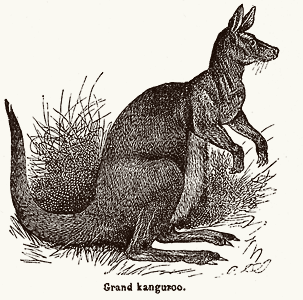Kangaroo

KANGAR00 s. Mamm. Kind of marsupial, which includes several species of quadrupeds living in Australia and the nearby islands, remarkable by the volume of their tail, which they use for leaping, and by the amazing length of their lower limbs. Kangaroos feed on plants, grazing like ruminants and like them, according to Owen, they sometimes chew twice the food contained in their first stomach; they vary in height, from that of a man to that of a hare; when grazing, they put their forefeet on the ground, but otherwise they rest on the tripod formed by their hindlegs and their tail, with the upper part of the body slightly bent forward. They are the only marsupials not to be nocturnal. The largest and best known species is the large kanguroo (macropus giganteus, Shaw), discovered in 1770 on the coast of New South Wales during Cook’s first travel; an adult male owned by the British museum, measures 175 cm (5’9″) from the tip of the nose to the root of the tail; the latter being 4’3″ long; the female kangaroo is approximately one third smaller. The hair is soft and not very long; of a brownish grey color on the back and of a paler gray on the belly; the feet and the end of the tail are black. These animals seek grassy hills, open plains and regions where they can graze grass and small bushes. Their forefeet are prehensile; they use them when nursing their young. Kangaroos generally do not go in troops. Their skin is valued as producing a leather from which shoes and gloves are made; their flesh is considered a refined dish.
Extract from the Trousset encyclopedia, 1886 – 1891
Tags: animals, Australia, mammals, marsupials, Trousset encyclopedia


